Gorilla Wood Glue: Strong Bonding for Woodworking Projects
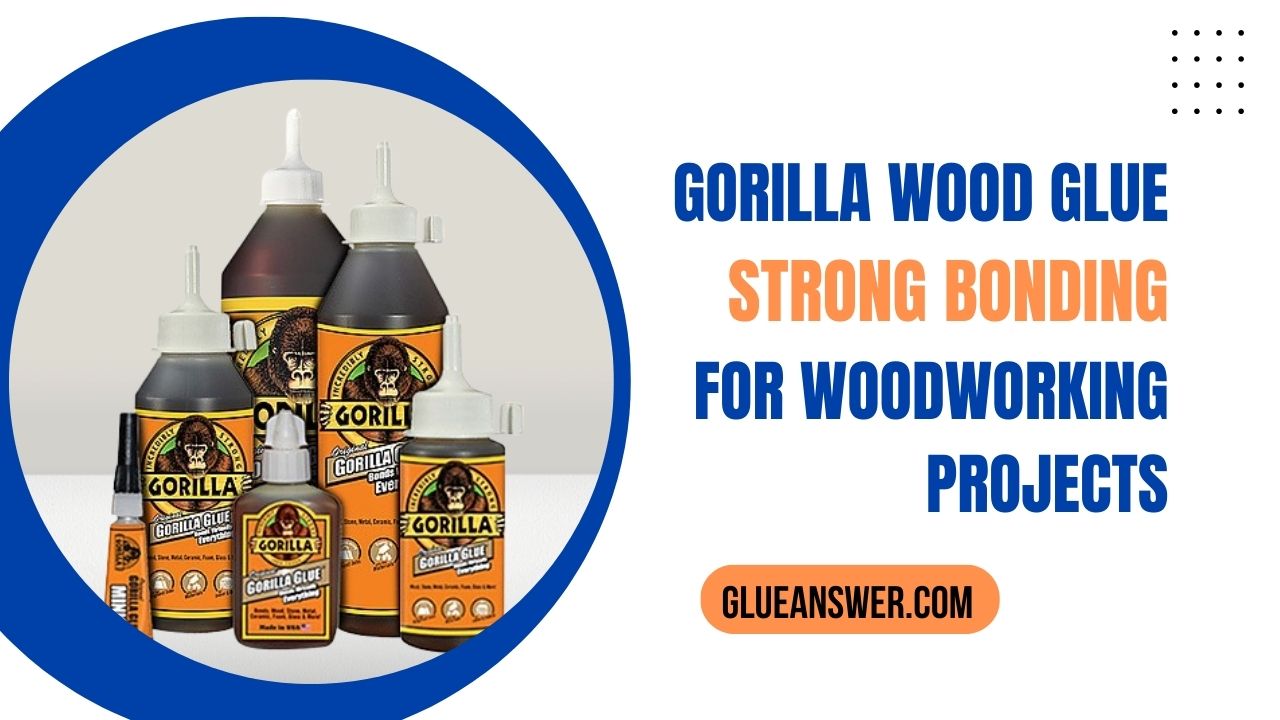
Gorilla Wood Glue: A Woodworker’s Friend, But Is It Right for You?
Gorilla Wood Glue. The name conjures images of powerful bonds and sturdy DIY projects. But is it all hype, or a true woodworking staple? This glue boasts impressive strength, claiming to hold thousands of pounds per square inch. It dries clear, a plus for visible joints, and offers decent water resistance for some outdoor projects. Sounds perfect, right?
However, like any product, Gorilla Wood Glue has its limitations. Gap filling abilities are limited, and while strong, it might not be the absolute champion for every project. So, who should grab this glue and who should explore other options?
Dive into our comprehensive guide to discover if Gorilla Wood Glue is the missing piece in your woodworking puzzle.
What type of glue is gorilla wood glue
Type and Description:
- Type: Gorilla Wood Glue is a polyvinyl acetate (PVA) adhesive, also known as white glue or wood glue. These glues are popular for woodworking due to their ease of use, water-based nature, and strong bonding capabilities.
- Key Features:
- Water-resistant (standard formula) or waterproof (Ultimate formula)
- Strong bond on various wood types, including hardwoods, softwoods, and composites
- Dries clear for aesthetically pleasing results
- Sandable and paintable
- Relatively long open time for adjustments
- Easy cleanup with water
Gorilla Glue wood Adhesive instructions
Instructions:
- Prepare Surfaces: Ensure surfaces are clean, dry, and free of dirt, grease, or oils. Sanding may be necessary for better adhesion.
- Apply Glue: Use a brush or squeeze bottle to apply a thin, even layer of glue to one surface.
- Assemble and Clamp: Join the surfaces and apply firm, even pressure using clamps or other suitable methods. Clamping time typically ranges from 20-30 minutes, but consult the specific product instructions for optimal results.
- Wipe Up Excess: Remove any excess glue with a damp cloth before it dries.
- Drying: Allow the glue to dry completely before handling or further processing. Drying time usually takes 24 hours, but refer to the product information for accurate guidance.
Read More About How to use Glue Gun for Wax Seals – Sealing Wax with Glue Gun
Gorilla wood glue advantages and disadvantages
Advantages and Disadvantages:
Advantages of gorilla glue:
- Strong Bond: Gorilla Wood Glue creates a durable bond that can withstand most woodworking applications.
- Water Resistance: The standard formula offers water resistance, while the Ultimate formula is fully waterproof, making it suitable for outdoor projects.
- Versatility: Bonds a wide range of wood types and some other materials.
- Ease of Use: Water-based, requires minimal prep, and cleans up easily.
- Dries Clear: Invisible bond line for aesthetically pleasing results.
- Long Open Time: Allows for adjustments during assembly.
Disadvantages of gorilla glue:
- Not Heat-Resistant: Avoid using in high-temperature areas as it can weaken the bond.
- Not Solvent-Resistant: Not suitable for bonding materials exposed to solvents.
- Limited Gap Filling: Not ideal for large gaps.
- Longer Drying Time: Compared to some specialized glues, its drying time can be a bit longer.
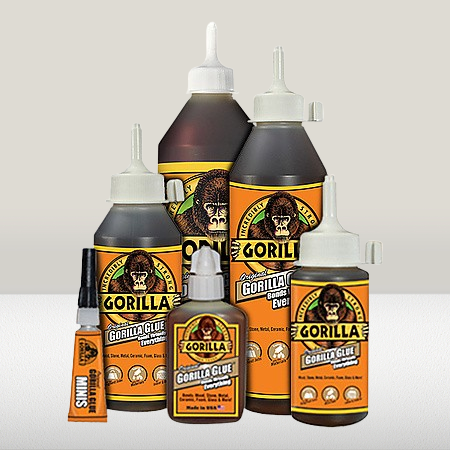
Gorilla glue wood adhesive
Specific Products:
- Gorilla Wood Glue: The standard formula, water-resistant for indoor and some outdoor projects.
- Gorilla Wood Glue Ultimate: Waterproof formula for demanding outdoor applications.
- Gorilla Wood Glue 532ml: Larger bottle size for frequent use or big projects.
Gorilla wood glue dry time – how long does gorilla wood glue take to dry
So, how long for gorilla wood glue to dry?
The drying time of Gorilla Wood Glue depends on a few factors, but here’s the breakdown:
- Clamping Time: This refers to how long you need to apply pressure to the glued surfaces for optimal bonding. For Gorilla Wood Glue, the standard clamping time is 20-30 minutes at room temperature (above 55°F).
- Initial Drying Time: This is the time it takes for the glue to become 80% dry. For Gorilla Wood Glue, this typically takes 1-2 hours.
- Full Cure Time: This is the time it takes for the glue to reach its maximum strength. For Gorilla Wood Glue, the full cure time is 24 hours.
Factors Affecting Drying Time:
- Temperature: Warmer temperatures generally lead to faster drying times. However, avoid exceeding temperatures specified by the manufacturer, as it can weaken the bond.
- Humidity: Lower humidity allows for faster drying. In very humid environments, drying may take longer.
- Glue Thickness: Applying a thicker layer of glue will naturally take longer to dry.
- Wood Type: More porous woods may absorb some glue, affecting drying time slightly.
- Joint Size: Larger joints with more glue coverage may take longer to dry completely.
Tips for Optimal Drying:
- Ensure surfaces are clean, dry, and at room temperature before gluing.
- Apply clamps with adequate pressure for the recommended clamping time.
- Maintain moderate temperature and humidity during drying.
- Allow sufficient ventilation (as long as it doesn’t affect temperature or humidity).
- Avoid handling or moving the glued parts until fully cured.
Gorilla wood glue price
Pricing: Prices vary depending on size and retailer. Generally, Gorilla Wood Glue falls within the mid-range of wood glue prices.
1. 4-ounce bottle: $4-$7 USD
Gorilla Wood Glue 4ounce bottle

2. 8-ounce bottle: $6-$10 USD
Gorilla Wood Glue 8ounce bottle
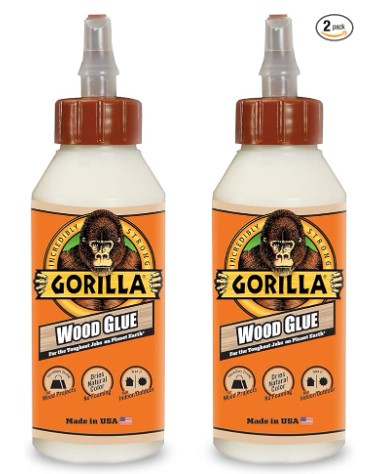
3. 16-ounce bottle: $8-$13 USD
Gorilla Wood Glue 16ounce bottle
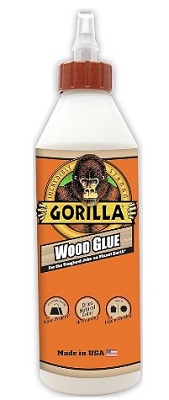
4. 32-ounce bottle: $12-$18 USD
Gorilla Wood Glue 32ounce bottle
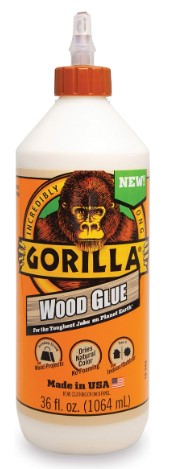
5. 1-gallon bottle: $20-$30 USD
Gorilla Wood Glue 1gallon bottle
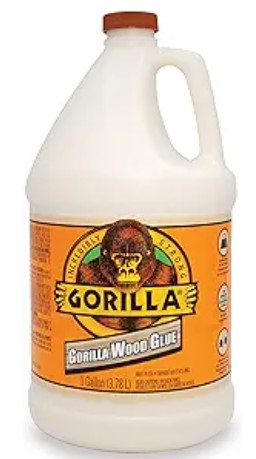
What’s better than gorilla glue: Alternatives
Consider Titebond, Elmer’s Carpenter’s Wood Glue, or specialist glues like polyurethane glue for specific needs.
How long for gorilla epoxy to cure
Gorilla Epoxy Cure Time: Gorilla Epoxy cures in 24 hours for most applications. Refer to the specific product instructions for exact details.
How to open gorilla wood glue?
Opening Gorilla Wood Glue: The bottle has a twist-off cap. If it’s hard to open, use pliers or a wrench with caution to avoid damaging the bottle.
Gorilla glue vs wood glue
While Gorilla Wood Glue is a well-known brand, it falls under the broader category of “wood glue.” So, technically, “gorilla glue vs wood glue” isn’t an apples-to-apples comparison. However, let’s break down the nuances:
1. Gorilla Wood Glue:
- Type: Polyvinyl acetate (PVA) glue, also known as white glue.
- Key Features:
- Water-resistant (standard formula) or waterproof (Ultimate formula)
- Strong bond on various wood types
- Dries clear
- Sandable and paintable
- Long open time for adjustments
- Easy cleanup with water
- Pros: Strong, versatile, user-friendly, good value for money.
- Cons: Not heat-resistant or solvent-resistant, limited gap filling.
2. Wood Glue:
- Term encompasses numerous glues: PVA (like Gorilla Wood Glue), polyurethane, epoxy, casein, etc.
- Properties vary considerably: Each type has unique strengths, weaknesses, and applications.
- Pros: Can offer specialized features like superior water resistance, heat resistance, or gap filling.
- Cons: Some types may be complex to use, toxic, expensive, or require special conditions for drying.
Choosing the Right Glue:
The best wood glue for you depends on your specific project and needs. Here are some factors to consider:
- Wood type: Some glues are better suited for certain woods than others.
- Joint strength: How strong and durable does the bond need to be?
- Water resistance: Does the project need to withstand moisture?
- Heat resistance: Will the glued joint be exposed to high temperatures?
- Ease of use: How comfortable are you with different types of glue?
- Cost: What is your budget?
Comparison Summary:
| Feature | Gorilla Wood Glue | Wood Glue (General) |
| Type | PVA glue | Can be PVA, polyurethane, epoxy, etc. |
| Water resistance | Standard: Water-resistant, Ultimate: Waterproof | Varies depending on type |
| Strength | Strong | Varies depending on type |
| Versatility | Good for various wood types and projects | Varies depending on type |
| Ease of use | Easy to use | Varies depending on type |
| Cost | Mid-range | Varies depending on type |
Remember: While Gorilla Wood Glue is a high-quality option, explore other wood glues if your project demands specific features.
Gorilla Wood Glue vs ultimate
Gorilla Wood Glue vs. Gorilla Wood Glue Ultimate: A Head-to-Head Comparison
Both Gorilla Wood Glue and Gorilla Wood Glue Ultimate are PVA adhesives, but they have some key differences that make them suitable for different applications. Here’s a breakdown:
| Feature | Gorilla Wood Glue | Gorilla Wood Glue Ultimate |
| Water Resistance | Water-resistant | Waterproof (passes ANSI/HPVA Type 1 water-resistance test) |
| Open Assembly Time | Up to 10 minutes | Up to 15 minutes |
| Clamp Time | 20-30 minutes | 20-30 minutes |
| Full Cure Time | 24 hours | 24 hours |
| Low Temperature Application | Down to 50°F | Down to 35°F |
| Price | Lower | Higher |
| Best For | Indoor projects, some outdoor projects | Outdoor projects exposed to moisture, demanding applications |
Here’s a deeper dive into their strengths and weaknesses:
1. Gorilla Wood Glue:
- Strengths: More affordable, good for indoor woodworking, strong enough for most projects.
- Weaknesses: Not fully waterproof, shorter open assembly time than Ultimate.
2. Gorilla Wood Glue Ultimate:
- Strengths: Completely waterproof, longer open assembly time for adjustments, stronger bond, can be used at lower temperatures.
- Weaknesses: More expensive, slightly longer clamp time than standard glue.
Ultimately, the best choice for you depends on your project’s needs:
- Choose Gorilla Wood Glue for: Indoor projects, general woodworking, cost-effectiveness.
- Choose Gorilla Wood Glue Ultimate for: Outdoor projects exposed to moisture, demanding applications where strength and water resistance are crucial, projects requiring more time for adjustments.
Gorilla Wood Glue vs Titebond
Gorilla Wood Glue vs. Titebond: A Comprehensive Comparison
Both Gorilla Wood Glue and Titebond are popular PVA (polyvinyl acetate) adhesives commonly used in woodworking projects. Choosing the right one can be tricky, as they share similar strengths but also have distinct features. Here’s a breakdown to help you decide:
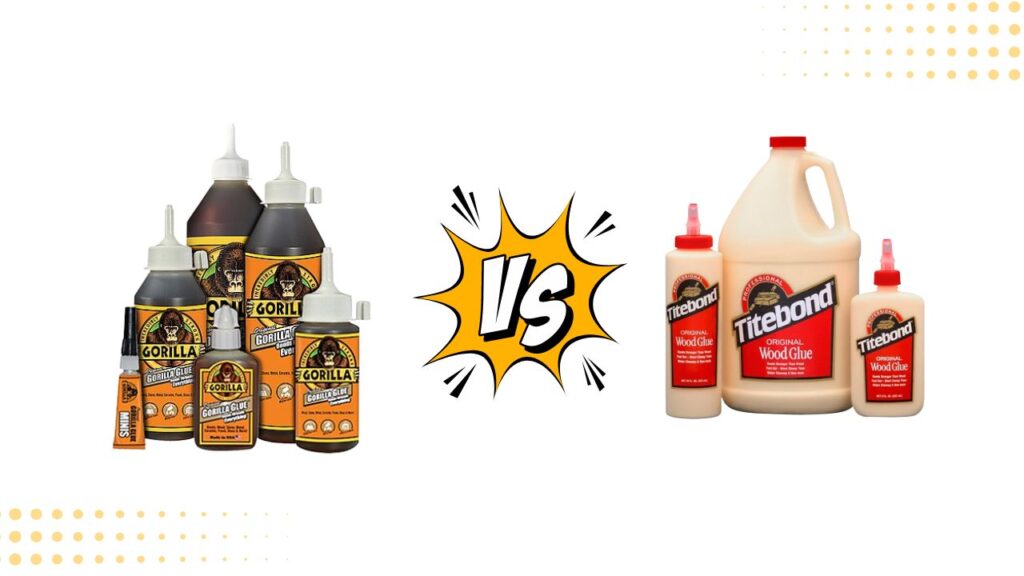
Key Similarities:
- Type: Both are PVA adhesives, known for strong bonds, ease of use, and water-resistant properties (with variations depending on specific formulas).
- Versatility: Both work well on various wood types and offer decent open times for adjustments.
- Cleaning: Both clean up easily with water.
Key Differences:
| Feature | Gorilla Wood Glue | Titebond |
| Formula Options | Standard water-resistant, Ultimate waterproof | Multiple formulas (II, III, Original, Ultimate, Liquid Hide Glue, etc.) with varying water resistance, strength, and drying times |
| Bond Strength | Generally strong, particularly Ultimate | Considered slightly stronger in general, especially the III formula |
| Water Resistance | Standard: Water-resistant, Ultimate: Waterproof | Varies based on formula (II: water-resistant, III: waterproof, Original: moderate water resistance) |
| Gap Filling | Limited | Some formulas better at filling small gaps (Liquid Hide Glue) |
| Flexibility | Slightly more flexible than Titebond for slightly better stress resistance | Varies based on formula |
| Heat Resistance | Not highly heat-resistant | Some formulas (Liquid Hide Glue) offer better heat resistance |
| Open Time | Up to 10 minutes | Varies based on formula (III: longer open time) |
| Drying Time | 24 hours | Varies based on formula (III: slightly longer drying time) |
| Price | Mid-range | Varies based on formula, generally slightly more expensive than Gorilla Wood Glue |
Choosing the Right Glue:
The best choice depends on your specific project needs:
- Indoor projects: Both work well, but Titebond III might be slightly better for demanding applications due to its strength and waterproof nature.
- Outdoor projects: Choose a waterproof formula from either brand (Gorilla Ultimate or Titebond III).
- Gap filling: Consider Titebond Liquid Hide Glue if you need to fill small gaps.
- Heat resistance: For projects exposed to heat, explore Titebond Liquid Hide Glue or specialist heat-resistant glues.
- Specific needs: Titebond offers a wider range of formulas for specialized needs like flexibility (Titebond Original) or veneer work (Liquid Hide Glue).
- Budget: Gorilla Wood Glue is generally more affordable, but factor in project requirements and long-term value.
Titebond 3 vs Gorilla Wood Glue
Both Titebond III and Gorilla Wood Glue are highly regarded PVA glues commonly used in woodworking. Choosing between them depends on your project’s specific needs and priorities. Here’s a detailed comparison to help you decide:
Key Similarities:
- Type: Both are PVA adhesives, known for their strong bonds, ease of use, and water-resistant properties.
- Versatility: Both work well on various wood types and offer decent open times for adjustments.
- Cleaning: Both clean up easily with water.
Key Differences:
| Feature | Titebond III | Gorilla Wood Glue |
| Water Resistance | Waterproof (passes ANSI/HPVA Type 1 water-resistance test) | Standard formula: Water-resistant, Ultimate: Waterproof |
| Bond Strength | Slightly stronger, especially on hardwoods | Generally strong, Ultimate stronger than standard formula |
| Drying Time | Slightly longer (24-48 hours) | 24 hours |
| Open Time | Longer (up to 30 minutes) | Up to 10 minutes |
| Gap Filling | Limited | Limited |
| Flexibility | Less flexible | Slightly more flexible, better stress resistance |
| Heat Resistance | Limited | Limited |
| Ease of Use | Easy to use | Easy to use |
| Price | Generally more expensive | Generally more affordable, Ultimate similar in price |
Read More About Should I Use Dielectric Grease On Ignition Coils?
Gorilla Wood Glue vs. Elmer’s Wood Glue: A Head-to-Head Comparison
Both Gorilla Wood Glue and Elmer’s Wood Glue are popular woodworking adhesives, but they have key differences you should consider before choosing one for your project. Here’s a breakdown:
| Feature | Gorilla Wood Glue | Elmer’s Wood Glue |
| Type | Polyvinyl acetate (PVA) | Various types (PVA, polyurethane, aliphatic resin) |
| Water Resistance | Standard: Water-resistant, Ultimate: Waterproof | Varies based on type (Elmer’s Wood Glue: Water-resistant, Carpenter’s Wood Glue: Water-resistant with higher strength) |
| Bond Strength | Generally strong, particularly Ultimate | Varies based on type (Elmer’s Wood Glue: Moderate, Carpenter’s Wood Glue: Stronger) |
| Drying Time | 24 hours | Varies based on type (Elmer’s Wood Glue: 20-30 minutes, Carpenter’s Wood Glue: 24-48 hours) |
| Open Time | Up to 10 minutes | Varies based on type (Elmer’s Wood Glue: Short, Carpenter’s Wood Glue: Longer) |
| Ease of Use | Easy to use | Easy to use (Elmer’s Wood Glue), some types require more care (Carpenter’s Wood Glue) |
| Price | Mid-range | Varies based on type (Elmer’s Wood Glue: More affordable, Carpenter’s Wood Glue: Similar to Gorilla Wood Glue) |
| Ideal For | Indoor projects, some outdoor projects (Ultimate) | Various applications depending on type (Elmer’s Wood Glue: General crafting, Carpenter’s Wood Glue: Stronger projects) |
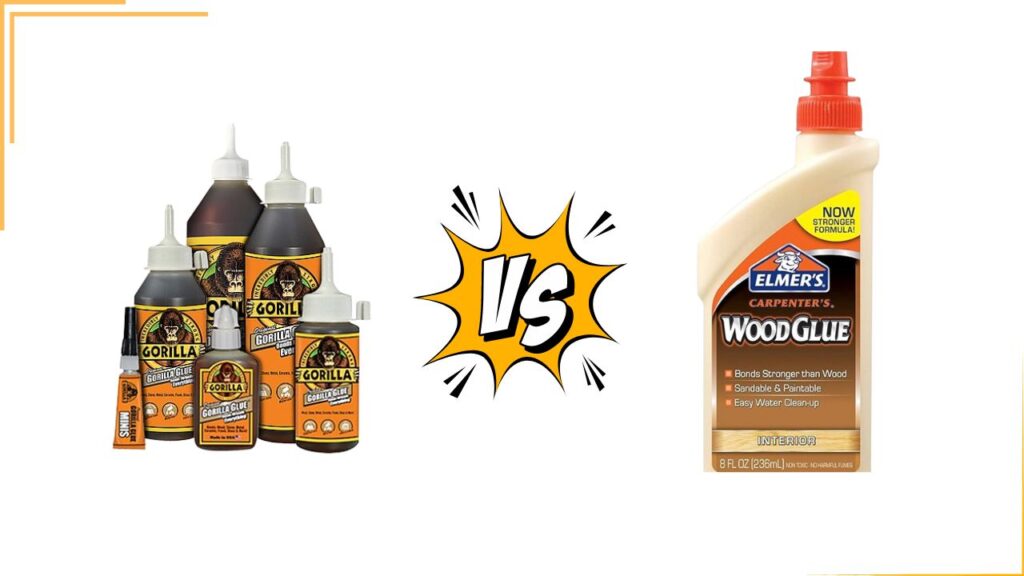
Key Differences:
- Water resistance: Gorilla Wood Glue Ultimate offers superior water resistance compared to Elmer’s standard Wood Glue. Choose Carpenter’s Wood Glue for a more water-resistant option from Elmer’s.
- Bond strength: Both brands offer strong options, but Gorilla Wood Glue Ultimate and Elmer’s Carpenter’s Wood Glue generally provide higher strength than their standard counterparts.
- Drying time: Elmer’s Wood Glue dries faster than Gorilla Wood Glue, while Carpenter’s Wood Glue has a similar drying time.
- Open time: Carpenter’s Wood Glue offers a longer open time for adjustments than Gorilla Wood Glue and Elmer’s Wood Glue.
- Ease of use: Both are generally easy to use, but Carpenter’s Wood Glue might require slightly more care due to its thicker consistency.
- Price: Elmer’s Wood Glue is more affordable, while Carpenter’s Wood Glue is similar in price to Gorilla Wood Glue.
Choosing the Right Glue:
- Indoor projects: Either option can work well depending on your expected level of moisture exposure. For demanding tasks, consider Carpenter’s Wood Glue.
- Outdoor projects: Choose Gorilla Wood Glue Ultimate or Elmer’s Carpenter’s Wood Glue for their water resistance.
- Need for a strong bond: Carpenter’s Wood Glue and Gorilla Wood Glue Ultimate offer superior strength.
- Need for quick drying: Choose Elmer’s Wood Glue if drying time is crucial.
- Value-conscious: Elmer’s Wood Glue is more affordable for general tasks, but consider cost-effectiveness in relation to project requirements.
Gorilla wood glue vs pva
While Gorilla Wood Glue is a type of PVA glue, there are some nuances to understand to properly compare them:
1. Gorilla Wood Glue:
- Specific PVA formula: Has its own unique formulation within the broader PVA category.
- Key features:
- Water-resistant (standard formula) or waterproof (Ultimate formula)
- Strong bond on various wood types
- Dries clear
- Sandable and paintable
- Longer open time for adjustments
- Easy cleanup with water
- Pros: Strong, versatile, user-friendly, good value for money.
- Cons: Not heat-resistant or solvent-resistant, limited gap filling.
PVA Glue (General):
- Broad category: Encompasses many different PVA formulas with varying properties.
- General characteristics:
- Water-based adhesives
- Relatively strong and versatile
- Dries clear
- Easy to use and clean up
- Affordable
- Properties vary: Specific strengths, weaknesses, and applications depend on the individual PVA formula.
Comparison Summary:
| Feature | Gorilla Wood Glue | PVA Glue (General) |
| Type | Specific PVA formula | Various PVA formulas |
| Water resistance | Standard: Water-resistant, Ultimate: Waterproof | Varies depending on formula |
| Strength | Strong, particularly Ultimate | Varies depending on formula |
| Versatility | Good for various wood types | Varies depending on formula |
| Ease of use | Easy to use | Varies depending on formula |
| Cost | Mid-range | Varies depending on formula |
Choosing the Right Option:
Since “PVA glue” doesn’t represent a specific product but a category, you’ll need to consider the specific PVA formula you’re comparing to Gorilla Wood Glue:
- If the PVA formula offers similar features like strength, water resistance, and drying time as Gorilla Wood Glue, it might be a good alternative based on price and availability.
- However, if your project requires specific capabilities beyond what Gorilla Wood Glue offers, exploring different PVA formulas with specialized features like heat resistance, gap filling, or faster drying might be necessary.
Gorilla Wood Glue vs Epoxy: What’s the Right Choice for Your Project?
Both Gorilla Wood Glue and epoxy are popular adhesives used in woodworking, but they have distinct strengths and weaknesses. Choosing the right one depends on your specific project needs. Here’s a breakdown to help you decide:
| Feature | Gorilla Wood Glue | Epoxy |
| Type | Polyvinyl acetate (PVA) | Two-part adhesive (resin and hardener) |
| Water Resistance | Standard: Water-resistant, Ultimate: Waterproof | Generally waterproof, with variations depending on specific epoxy formula |
| Bond Strength | Strong, particularly Ultimate | Very strong, often superior to PVA glues |
| Gap Filling | Limited | Excellent, can fill larger gaps and uneven surfaces |
| Heat Resistance | Limited | More heat-resistant than wood itself, with variations depending on formula |
| Chemical Resistance | Not solvent-resistant | More solvent-resistant than wood itself, with variations depending on formula |
| Drying Time | 24 hours | Varies depending on the specific epoxy (some cure quickly, others take longer) |
| Open Time | Up to 10 minutes | Usually very short (few minutes to hours), requires quick application |
| Ease of Use | Easy to use | More complex due to two-part mixing and short open time |
| Price | Mid-range | Generally more expensive than PVA glue |
Key Differences:
- Strength: Epoxy generally offers superior bond strength, especially for demanding tasks.
- Gap Filling: Epoxy excels at filling gaps and uneven surfaces, while Gorilla Wood Glue is limited in this aspect.
- Water and Chemical Resistance: Both Epoxy and Gorilla Wood Glue Ultimate offer good water resistance, but epoxy generally provides better chemical resistance.
- Drying Time and Open Time: Epoxy often dries faster than Gorilla Wood Glue but has a much shorter open time, requiring faster application.
- Ease of Use: Gorilla Wood Glue is user-friendly, while mixing and using epoxy requires more care and accuracy.
- Price: Epoxy is generally more expensive than Gorilla Wood Glue.
Choosing the Right Glue:
- For general woodworking: Gorilla Wood Glue is a good choice for its ease of use, affordability, and strong bonds.
- For outdoor projects: Choose Gorilla Wood Glue Ultimate for water resistance or explore waterproof epoxy formulas.
- For strong joints, gap filling, or heat/chemical resistance: Epoxy is often the better option.
- For intricate projects requiring long open time: Gorilla Wood Glue is more forgiving.
- For budget-conscious projects: Gorilla Wood Glue offers good value.
Gorilla wood glue vs Liquid nail
While both Gorilla Wood Glue and Liquid Nails are commonly used adhesives, they are designed for different purposes and have distinct properties. Here’s a breakdown to help you choose the right one for your project:
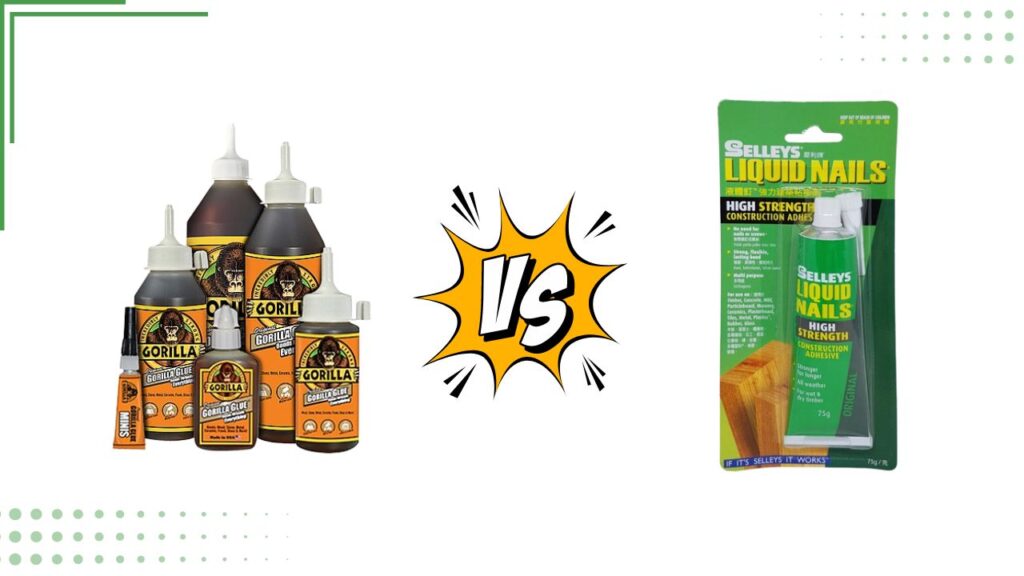
1. Gorilla Wood Glue:
- Type: Polyvinyl acetate (PVA) glue
- Key Features:
- Water resistance: Standard: Water-resistant, Ultimate: Waterproof
- Strong bond on various wood types
- Dries clear
- Sandable and paintable
- Longer open time for adjustments
- Easy cleanup with water
- Pros: Strong, versatile, user-friendly, good value for money.
- Cons: Not heat-resistant or solvent-resistant, limited gap filling.
- Best for: Bonding well-fitting wood joints, indoor projects, some outdoor projects (Ultimate formula).
2. Liquid Nails:
- Type: Construction adhesive (can vary depending on specific formula)
- Key Features:
- Stronger bond: Generally stronger than Gorilla Wood Glue, even stronger for specific formulas like Liquid Nails Fuze It!
- Gap filling: Excellent for larger gaps and uneven surfaces
- More flexible: Some formulas offer flexibility for slightly moving joints
- Variety of formulas: Different formulas target specific materials and conditions
- Pros: High bond strength, gap filling, can handle some movement, diverse applications.
- Cons: Not as user-friendly as Gorilla Wood Glue, some formulas have strong odors, drying time can vary significantly.
- Best for: Bonding uneven surfaces, large gaps, outdoor projects needing strong weather resistance, specific applications like subfloors or countertops.
Choosing the Right Glue:
- For bonding well-fitting wood joints: Gorilla Wood Glue is usually sufficient.
- For large gaps or uneven surfaces: Choose Liquid Nails.
- For outdoor projects: Choose Liquid Nails with suitable water resistance (e.g., Liquid Nails Heavy Duty Construction Adhesive) or Gorilla Wood Glue Ultimate.
- For demanding applications requiring high strength: Liquid Nails, especially specific formulas like Fuze It!, might be preferred.
- For ease of use and cleaning: Gorilla Wood Glue is simpler.
- For specific materials or conditions: Consider Liquid Nails’ diverse range of formulas.
Gorilla Construction Adhesive vs Gorilla Wood Glue: Choosing the Right Option
Both Gorilla Construction Adhesive and Gorilla Wood Glue are strong adhesives made by the Gorilla brand, but they cater to different applications. Here’s a breakdown to help you choose the right one:
| Feature | Gorilla Construction Adhesive | Gorilla Wood Glue |
| Type | Construction adhesive (varies depending on formula) | Polyvinyl acetate (PVA) glue |
| Main Purpose | Bonding various materials (wood, concrete, masonry, etc.) | Bonding wood joints |
| Bond Strength | Generally stronger than PVA glue, stronger formulas available | Strong, especially Ultimate formula |
| Gap Filling | Excellent, can fill large gaps and uneven surfaces | Limited gap filling |
| Water Resistance | Varies depending on formula (most are water-resistant, some waterproof) | Standard: Water-resistant, Ultimate: Waterproof |
| Drying Time | Varies depending on formula (generally longer than wood glue) | 24 hours |
| Open Time | Varies depending on formula (generally shorter than wood glue) | Up to 10 minutes |
| Ease of Use | Can be less user-friendly, some formulas require mixing | Easy to use, cleans up easily with water |
| Price | Varies depending on formula (generally more expensive than wood glue) | Mid-range, Ultimate formula similar to some construction adhesives |
| Applications | Subfloors, countertops, concrete repairs, outdoor projects, heavy-duty bonding | Interior woodworking, general wood projects, some outdoor projects (Ultimate) |
How to use gorilla wood glue?
Here’s a guide on how to use Gorilla Wood Glue effectively:
1. Preparation:
- Clean and dry surfaces: Ensure the wood surfaces you’re bonding are clean, free of dust, dirt, grease, and moisture. Sanding lightly can improve adhesion.
- Read the label: Double-check the specific instructions for your Gorilla Wood Glue formula (standard or Ultimate), as there might be slight variations.
2. Applying the Glue:
- Apply generously: Use a brush or applicator bottle to spread a thin, even layer of glue onto one surface of the joint. Don’t overapply, as excess glue can weaken the bond.
- Spread the glue: Make sure the glue covers the entire bonding area, especially the ends of the joint.
- Clamp for proper pressure: Use clamps to apply firm and even pressure on the joint for the recommended clamping time (usually 20-30 minutes). Ensure the clamps don’t damage the wood.
3. Tips for Optimal Bonding:
- Open time: Work within the open time (up to 10 minutes) of the glue before clamping, as the adhesive sets quickly.
- Temperature: Apply the glue at room temperature (above 55°F) for optimal results.
- Humidity: Avoid applying the glue in excessively humid environments.
- Wipe away excess: Use a damp cloth to remove any squeezed-out glue before it dries.
- Cleaning: Use water to clean brushes or tools while the glue is still wet.
How strong is gorilla wood glue?
Gorilla Wood Glue offers impressive strength, but the exact level depends on the specific formula you consider:
1. Standard Gorilla Wood Glue:
- Tensile strength: Up to 3,800 psi (pounds per square inch)
- Shear strength: Up to 2,400 psi
- Bond strength: Can hold up to 500 lbs per square inch of bonded area under ideal conditions
2. Gorilla Wood Glue Ultimate:
- Tensile strength: Up to 4,200 psi
- Shear strength: Up to 2,900 psi
- Bond strength: Can hold up to 600 lbs per square inch of bonded area under ideal conditions
Will gorilla wood glue work on plastic – can gorilla wood glue be used on plastic?
While Gorilla Wood Glue is not recommended for most plastics, there are some caveats and specific types of plastic where it might work with limited success. Here’s a breakdown:
1. General Recommendation:
- Do not use Gorilla Wood Glue on most plastics. It’s designed for wood and may not create a strong or long-lasting bond on plastic due to incompatibility with the material.
2. Reasons for Not Using on Most Plastics:
- Lack of proper adhesion: The glue might not adhere well to the plastic surface, leading to a weak bond that can easily fail.
- Chemical incompatibility: Some plastics can react negatively with the glue’s ingredients, causing damage or weakening the bond.
- Drying concerns: The glue might not dry properly on non-porous plastic surfaces, potentially remaining tacky or soft.
3. Possible Exceptions (Use with Caution):
- Limited success on specific plastics: Gorilla Wood Glue might work on hard, non-porous plastics like ABS or PVC in some cases. However, testing on scrap plastic is essential before using it on your project.
- Specific Gorilla Glue products: Gorilla offers a Super Glue product specifically designed for bonding plastic, which might be a better option for plastic bonding needs.
Is it ok to stain wood before wood glue?
It’s generally not recommended to stain wood before using wood glue. Here’s why:
Reasons not to stain before gluing:
- Reduced adhesion: Stain creates a thin film on the wood that can prevent the glue from fully adhering to the underlying wood fibers, leading to a weaker bond that may fail over time.
- Unevenness: Stain may not absorb evenly into the wood, creating areas with weaker gluing potential.
- Glue visibility: Wood glue shows up white on unstained wood, making cleanup easier compared to stained wood where imperfections stand out more.
Alternatives:
- Glue first, stain later: This offers better adhesion and allows you to hide any glue squeeze-out with stain.
- Use a stainable wood glue: Some specialized wood glues are formulated to be compatible with stain, but test on scrap wood first to ensure desired results.
- Pre-stain conditioner: Applying a pre-stain conditioner before staining can help even out stain absorption and potentially improve wood glue adhesion. However, testing is still recommended.
Exceptions:
- Non-critical projects: For small, non-critical projects where a strong bond isn’t crucial, staining before gluing might be acceptable. However, proceed with caution and observe the bond strength carefully.
- Specific stain and glue combinations: In rare cases, specific stain and glue combinations might work together if compatibility is confirmed through rigorous testing and manufacturer recommendations.
Epoxy wood glue
Epoxy Wood Glue
- General description: A two-part adhesive consisting of resin and hardener, offering superior strength, gap-filling ability, and water resistance compared to most clear wood glues.
- Advantages:
- Exceptionally strong and durable, suitable for demanding applications.
- Excellent gap-filling capabilities for uneven surfaces.
- Highly water-resistant, often ideal for outdoor projects or damp environments.
- Disadvantages:
- More complex to use due to mixing and shorter working time.
- Can be more expensive than most clear wood glues.
- May not be as aesthetically pleasing due to potential yellowing over time.
Clear wood glue
- General description: A type of wood glue that dries transparent, making it ideal for visible joints and applications where you want to maintain the natural appearance of the wood.
- Common types: Polyvinyl acetate (PVA) glues, polyurethane (PUR) glues, and aliphatic resin glues.
- Advantages:
- Dries clear for visually appealing joints.
- Bonds well to various wood types.
- Relatively easy to use and clean up.
- Generally water-resistant (some formulas even waterproof).
- Disadvantages:
- Might not be as strong as some opaque glues, especially for demanding applications.
- Drying time can vary depending on the type and formula.
- Open time (working time for adjustments) may be shorter than opaque glues.
Opens in a new window amazon.com
Clear wood glue
Does clear gorilla glue work on wood?
Yes, clear Gorilla Glue does work well on wood in many situations. Here’s a breakdown of its capabilities:
Types of clear Gorilla Glue:
- Gorilla Wood Glue: This is the standard PVA-based wood glue offered by Gorilla in a clear formula. It is a user-friendly and affordable option for general woodworking projects where a strong, clear bond is desired.
- Gorilla Wood Glue Ultimate: This formula offers improved water resistance and slightly higher strength compared to the standard version. It also comes in a clear option.
Loctite wood glue
I’d be glad to provide information about clear wood glue, epoxy wood glue, and specific products like Gorilla Glue and Loctite:
1. Clear Wood Glue
- General description: A type of wood glue that dries transparent, making it ideal for visible joints and applications where you want to maintain the natural appearance of the wood.
- Common types: Polyvinyl acetate (PVA) glues, polyurethane (PUR) glues, and aliphatic resin glues.
- Advantages:
- Dries clear for visually appealing joints.
- Bonds well to various wood types.
- Relatively easy to use and clean up.
- Generally water-resistant (some formulas even waterproof).
- Disadvantages:
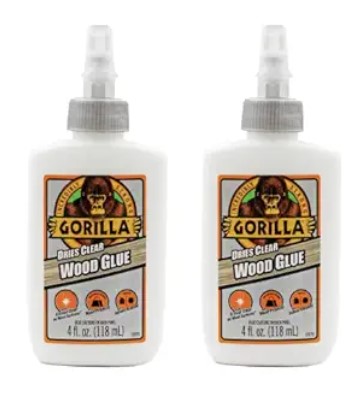
2. Epoxy Wood Glue
- General description: A two-part adhesive consisting of resin and hardener, offering superior strength, gap-filling ability, and water resistance compared to most clear wood glues.
- Advantages:
- Exceptionally strong and durable, suitable for demanding applications.
- Excellent gap-filling capabilities for uneven surfaces.
- Highly water-resistant, often ideal for outdoor projects or damp environments.
- Disadvantages:
- More complex to use due to mixing and shorter working time.
- Can be more expensive than most clear wood glues.
- May not be as aesthetically pleasing due to potential yellowing over time.
3. Gorilla Glue (Clear and Epoxy)
- Clear Gorilla Glue: A PVA-based clear wood glue known for its ease of use, strong bond, and water resistance. Popular choice for general woodworking projects where a clear bond is desired.
- Gorilla Epoxy: Two-part epoxy adhesive offering superior strength, gap-filling, and water resistance for demanding tasks and outdoor applications. Requires careful mixing and application within a shorter working time.
4. Loctite Wood Glue (Clear and Epoxy)
- Loctite Titebond Original Wood Glue: A classic PVA-based clear wood glue known for its versatility, strong bond, and sandability. Suitable for general woodworking and furniture making.
- Loctite Titebond Liquid Hide Glue: A water-resistant PVA-based clear wood glue derived from animal collagen. Offers strong bonds and flexibility, making it a good choice for instrument repairs and curved joints.
- Loctite Epoxy: Various epoxy formulas for different strength and gap-filling requirements. Can be a good option for demanding projects but requires proper handling and mixing.
Read More About Bluedevil Head Gasket Sealer 38386 Reviews
Can you paint over wood glue?
Yes, you can typically paint over wood glue once it has fully dried. However, here are some things to keep in mind:
- Make sure the glue is completely dry: This can take 24 hours or longer depending on the glue and the thickness of the application. Painting over wet glue can trap moisture and lead to peeling or other problems.
- Sand the glue smooth: If the glue is not level with the wood, it will show through the paint. Sand lightly to create a smooth surface for the paint to adhere to.
- Use a primer: A primer can help to seal the glue and provide a better surface for the paint to adhere to. This is especially important if you are using a water-based paint.
- Test on a scrap piece of wood: Before painting your entire project, test the paint and primer on a scrap piece of wood with glue to make sure there are no compatibility issues.
Does Gorilla Glue work on rubber?
It depends on the type of rubber. Gorilla Wood Glue (original and Ultimate) is not recommended for use on most rubbers due to the incompatibility of the adhesive with the material. It may not form a strong bond and could potentially damage the rubber.
However, Gorilla Super Glue Gel specifically mentions some rubber types it can bond, including nitrile, EPDM, and SBR. Always check the product label or manufacturer’s website for specific compatibility information.
Does Gorilla Glue work on plastic bottles?
Gorilla Wood Glue and Gorilla Super Glue are not recommended for use on most plastic bottles. Plastics like polyethylene (PE) and polypropylene (PP) are difficult for most adhesives to bond to due to their non-porous nature. The glue may not adhere properly and could damage the plastic.
For plastic bonding, consider specialized plastic adhesives designed for specific plastic types.
What materials does Gorilla Glue bond well with?
Gorilla Glue offers various products with different strengths and formulations, each suited for specific materials. Here’s a general overview:
- Gorilla Wood Glue: Best for bonding wood, including most common wood types like plywood, hardwood, and softwood.
- Gorilla Super Glue: Bonds a wide range of materials, including metal, plastic, wood, ceramics, leather, rubber (specific types), and more. Check the specific product information for compatible materials.
- Gorilla Construction Adhesive: Designed for heavy-duty bonding of various materials, including wood, concrete, masonry, metals, and more.
Is Gorilla Wood Glue permanent?
While Gorilla Wood Glue is an incredibly strong adhesive, it wouldn’t necessarily be considered “permanent” in every situation. Here’s a breakdown of its durability and some comparisons:
Permanence of Gorilla Wood Glue:
- Strong and long-lasting: When applied correctly and under ideal conditions, Gorilla Wood Glue forms a very strong bond that can withstand significant stress and last for many years.
- Not truly permanent: However, no adhesive is truly permanent. Factors like extreme temperatures, harsh chemicals, or continuous stress can potentially weaken the bond over extended periods.
Which Gorilla Glue is the strongest for wood?
Strongest Gorilla Glue for Wood:
- Gorilla Wood Glue Ultimate: This formula offers improved water resistance and slightly higher tensile strength (up to 4200 psi) compared to the standard Gorilla Wood Glue.
- Consider additional factors: While Ultimate is strongest in terms of raw strength, the “best” option might depend on specific project needs. For example, if gap filling is necessary, epoxy could be more suitable.
What is the best glue to glue wood to wood?
Best Glue for Wood-to-Wood Bonding:
- Gorilla Wood Glue (standard or Ultimate): A popular and reliable choice for general woodworking due to its strength, ease of use, and affordability.
- Other contenders: Depending on specific needs, consider:
- Epoxy: Excellent for strength, gap filling, and water resistance, but requires careful mixing and shorter working time.
- Aliphatic Resins: Similar to Gorilla Wood Glue in many ways but might offer better moisture resistance depending on the formula.
- Polyurethanes (PUR): Offer good strength, flexibility, and water resistance, but curing time can be longer.
Is Gorilla Wood Glue strong?
Strength of Gorilla Wood Glue:
- Very strong: It exceeds industry standards for wood-to-wood bonding and can hold up to thousands of pounds per square inch under ideal conditions.
- Compare with Ultimate: As mentioned, Gorilla Wood Glue Ultimate offers slightly higher strength than the standard formula.
Is Gorilla Glue stronger than wood glue?
Comparison with Other Wood Glues:
- Generally strong: Gorilla Wood Glue stands up well against comparable PVA glues in terms of strength and versatility.
- Consider specifics: The “strongest” depends on project demands. Epoxy often takes the top spot for extreme strength, while other glues might offer advantages in specific areas like flexibility or moisture resistance.
FAQs
Is Gorilla Wood Glue suitable for outdoor use?
Yes, Gorilla Wood Glue withstands outdoor conditions, offering robust weather resistance for lasting performance in various woodworking projects.
How long does it take for Gorilla Wood Glue to dry?
The drying time for Gorilla Wood Glue typically takes around 24 hours, ensuring a strong and secure bond between wood surfaces.
Can Gorilla Wood Glue be stained or painted after drying?
Yes, Gorilla Wood Glue allows for post-drying staining or painting, providing flexibility for customized finishes on your wood projects.
Is Gorilla Wood Glue waterproof?
While not fully waterproof, Gorilla Wood Glue exhibits water-resistant properties, making it ideal for indoor applications where exposure to moisture is limited.
What surfaces can Gorilla Wood Glue bond together?
Gorilla Wood Glue effectively bonds an array of wood surfaces, ensuring a durable and long-lasting connection for your woodworking endeavors.
Can Gorilla Wood Glue be used on hardwood and softwood?
Versatile in application, Gorilla Wood Glue works seamlessly on both hardwood and softwood, accommodating various wood types for versatile woodworking projects.
Is it safe to use Gorilla Wood Glue on food-contact surfaces?
Not recommended for food-contact surfaces, Gorilla Wood Glue is best suited for non-edible applications due to its composition and intended use.
Does Gorilla Wood Glue expand as it dries?
Gorilla Wood Glue exhibits minimal expansion during drying, offering controlled adhesion without compromising the precision of your woodworking projects.
Can Gorilla Wood Glue be sanded after drying?
Sanding is possible after full curing, allowing you to refine and perfect your wood projects even after the initial application of Gorilla Wood Glue.
What is the shelf life of Gorilla Wood Glue?
With a typical shelf life of one to two years, Gorilla Wood Glue remains reliable for an extended period, ensuring consistent performance when stored properly.
Final thoughts – Gorilla Wood Glue: Strong, Versatile, and User-Friendly
Gorilla Wood Glue shines as a reliable and easy-to-use adhesive for general woodworking projects. Its strong bond, clear drying, and water resistance make it a popular choice for creating long-lasting joints. While not “permanent,” it delivers impressive longevity under normal conditions.
For demanding tasks requiring maximum strength or gap filling, consider Gorilla Wood Glue Ultimate or explore epoxy options. Remember, the “best” glue depends on your specific project needs. Weigh factors like strength, water resistance, ease of use, and cost to make an informed decision.
Overall, Gorilla Wood Glue offers a solid balance of strength, affordability, and ease of use, making it a valuable tool for woodworkers of all levels.






